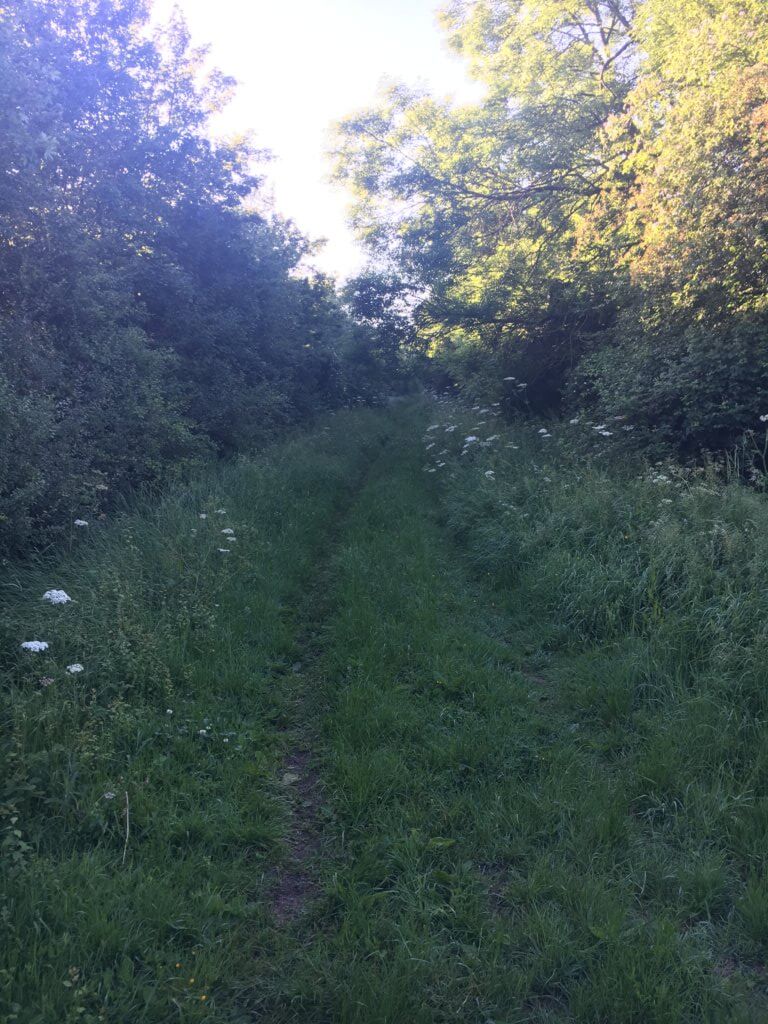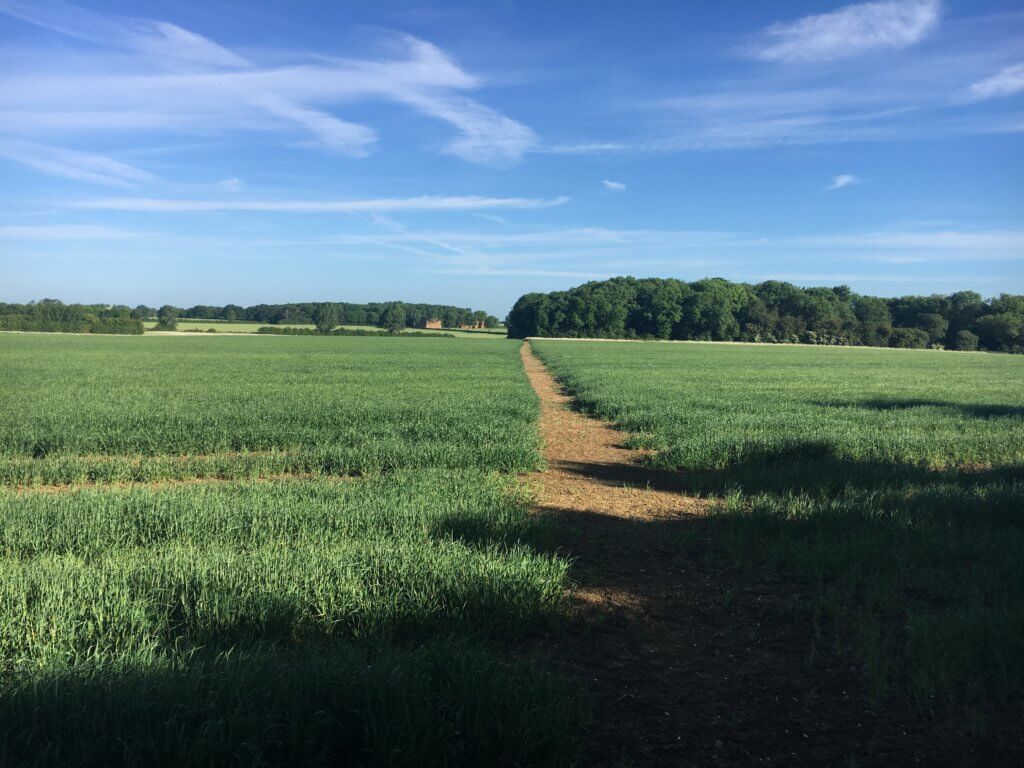
I did the second visit to my first BBS square yesterday – as I drove the few miles there and back there was news of the terror attack on London Bridge and at Borough Market. Crazy! I’m glad I live in a rural area but I’ve enjoyed snacking, dining, having my hair cut, having a drink and meeting friends in Borough Market plenty of times.
But one can lose yourself in nature, and I was keen to find out what birds I would see on this visit to my arable Breeding Bird Survey square on the Cambs/Northants border.
Things seemed a little quiet on the first visit and that was my impression as I started this visit too.
I start recording birds on the green lane pictured above – it looks a bit gloomy in the photo but it is often full of birds. Yellowhammers and Lesser Whitethroat on the first section made for a good start.
After the first three sections, the view opens out and I’ve got open field on one side of me and on the other side of the hedge. The sun was shining but my jeans were soaked up to my knees from the dew on the fieldside grasses. It was a bit quiet, but there were chattering Whitethroats and a few Skylarks pouring out their songs.
This is my thirteenth year recording birds here, and although that only adds up to 26 birding visits at this time of year, I feel I know the place and its birds quite well. The abandoned piece of farm equipment that made a useful seat at about half way to check my records and ensure that I could read them properly (!) is now surrounded by tall nettles so I couldn’t pause there. But I did hear a Mistle Thrush, as last year and one previous year, and it is where I often hear Song Thrush on the first visit. What I hadn’t seen so far was a Yellow Wagtail. The peak count was in my first year (9 in 2005) and was followed by 4 the next year but ever since numbers have been either 1 or 2 (with a blank in 2012). It’s usually this second visit that produces more of them than the first visit.
I guess I was trying harder than usual to spot or hear a Yellow Wagtail. I’m not sure that is ‘allowed’ (so don’t tell the BTO) but it is perfectly reasonable. But I didn’t get one. I can’t see any great differences in this place from the first year I surveyed it, but then I’m not looking with Yellow Wagtail eyes: there may be less food or more mammalian predators (there aren’t more avian ones), or maybe less suitable nest sites for some other reason. Or maybe it’s nothing to do with these arable fields – maybe the decline here is part of a more general decline caused by factors on the wintering grounds where ‘my’ Yellow Wagtails will be running around grassland with elephants, zebra and gazelles.
My observations can’t tell me why Yellow Wagtails are declining here, but they certainly add to the picture that they are declining. The first six years I counted this area provided nearly three times as many records of Yellow Wagtail as the last six years (two of which have been blank). That’s a bit sad. maybe they’ll surprise me next year with bumper numbers! Maybe.
I recorded 29 species this year (on two visits) compared with 31 species in 2005 – not much change (the range is 24-33 over that period). However, just for fun I looked at the 37 species which I recorded either in 2005 or 2017 or both; four hadn’t changed, 12 had increased and 21 had decreased in peak abundance. That illustrates the overall decline in numbers over the period. But mine is just one square in thousands – the strength of the survey is that it has so many randomly located sites which are counted in the same way each year. I’m really quite proud to be a part of such a joint endeavour.
And then it was back to my car and the depressing and saddening news of people killing each other.

In 1982 we had 4 pairs of Yellow Wagtail and in 1983 none and none since. This was the same year we lost 100 pairs of Sand Martins. Yes a total wipe out! This was the Sahel but since then Hay has turned to silage with earlier cutting leaving 1 location in the whole of Cumbria for Yellow Wagtail. This year [2017] there is only 1 male. Maize has destroyed one area of breeding and cattle full of chemicals on the other does not give great results!
My square within sight of the M1 near junction 19 on the second visit had 2 yellow wagtails, a first for my square.
I live only a mile away in the village of Lilbourne and yellow wags were a regular spring sighting up till 2011 when the fields I overlook were ploughed for the first time.
Just south of the village a new country park is being created Lilbourne Meadows and this seems to have attracted several dwindling species such as skylark, yellow hammer and even a migrating whinchat, so I hope the yellow wagtails will be next as the pair I saw were just half a mile away.
Mike – welcome and thanks for your comment.
Good luck with Lilbourne Meadows.
And could you give me my Yellow Wags back, please?!
Gearing up to my second BBS visits… one is a square I started in the pilot year of 1991. It never had any of the iconic farmland species apart from a couple of skylark, but it has regular woodland/hedge birds. The other (started 10 years ago) used to have Spotted Flycatcher, yellow wag, cuckoo and turtle dove – all now gone. The former is, if the National trust plans go ahead, to have one of the arable fields, bordering the first 5 sections on one side, turned into a large carpark. Part of me hopes that it becomes more interesting after this happens.
Some days I do muse on what the motivation is to walk mundane farmed land and see very few birds, when I could be visiting a reserve, but then I remember the rationale, to help inform on changing bird populations.
Oh yes, and there is the chance to count butterflies on ones BBS square in summer, too.
It is thanks to you and all those other citizen scientists waving magic wands of randomness, that statisticians can divine the true population trends and other secrets of our countryside.